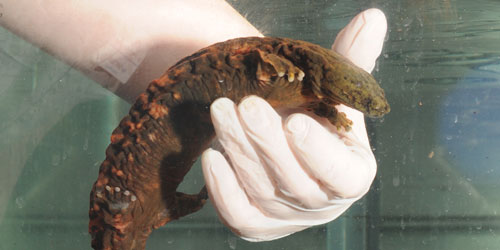
Dr. Yue-Wern Huang, Missouri S&T associate professor of biology, works with students to conduct hellbender research. Photos by B.A. Rupert

An Ozark Hellbender housed at the Saint Louis Zoo.

Yue-Wern Huang, an associate professor of biology at Missouri S&T, is trying to figure out where all of the hellbenders went. The hellbender is one of the largest salamanders in the world. They once thrived in the pristine streams of the Ozarks and Appalachia. Now they’re almost extinct.
It’s increasingly hard to find them and catch them, but Huang has been taking blood samples from hellbenders for nine years to see if their chemistry is changing over time. His research is funded by the Missouri Department of Natural Resources, the Missouri Department of Conservation, the U.S. Geological Survey, the Environmental Protection Agency, the Saint Louis Zoo, and the Missouri Water Resources Center.
Huang’s theory is that higher-than-normal estrogen levels in streams are disrupting the reproduction rates of hellbenders. The estrogen can come from pesticides and herbicides as well as from hormones in the waste of farm animals. It’s unclear how much damage relatively small amounts of pollution can cause, but when it comes to the health of a stream’s ecosystem, or maybe even the overall condition of a country’s water, Huang sees the hellbender as a kind of aquatic canary in the coal mine.
“The hellbender is very primitive,” Huang says. “They may be very sensitive to human activities that impact the water.”
Hellbenders are often incorrectly called mudpuppies. Although both are amphibians, mudpuppies have large external feathery gills. Learn more about Missouri’s hellbenders at the Saint Louis Zoo.
Recent Comments